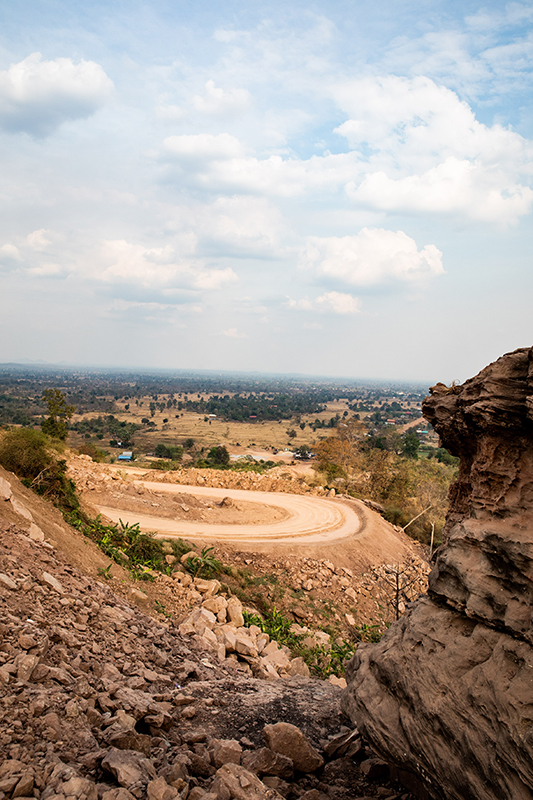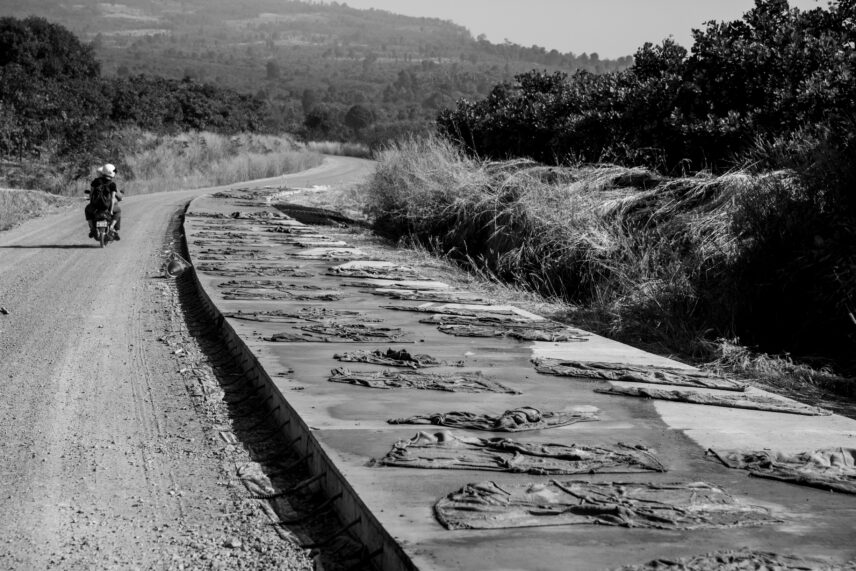Article begins
I was not in search of ghost stories when I learned of the dead boys. I was documenting accounts of encounters with other kinds of spirits. We were on Mount Kulen in northern Cambodia, sitting in a hut above a bend in the village road where the road is crossed by a spring, speaking with the village chief of Wrinkled Rock and his wife. The man was speaking of offerings made to placate the mountain guardian spirits for the disorder caused by an ongoing cross-plateau roadworks project. Two mechanical excavators became stuck in the road here, he said with enthusiasm. First, one was stuck and then a larger one came to pull it out, and it too became enmired, and they sank and sank and spring water flowed into the vehicles. A spirit medium had to be consulted, and a pig’s head and a pair of chickens had to be offered. The chief said that a guardian spirit was angry that the company had come to excavate the road without asking the spirit first. After the offerings, the very next morning, the mud dried up and the machines were freed.
“Two children died there, my child died there on the road in an explosion,” the village chief’s wife said suddenly. There was a war on, her husband agreed. The shift in topic confused me, but the village chief and his wife were old, and in a post-conflict landscape past tragedies sometimes rise in conversation and need to be held, gently, in the ghostly webs woven between speakers and listeners.
One of the boys was their son and the other their nephew. The war story itself was not clear. Either the boys had been made by the Khmer Rouge fighters to clear the road of landmines and ordnance or they gone out on their own after the fighting receded. Either way, the chief had gone away, and he had told them to stay with his wife, who was in post-partum confinement. The boys did not. They went down to the road, and they poked at an artillery shell with a branch. It detonated and they died, badly, one from a head injury and one from blood loss after losing both legs. These are very bad deaths, the death of children by violence, and the chief’s wife told us that every year they summoned the monks to their home for a ceremony where they recite the dead boys’ names.

Days later we met the boys’ cousin. She lived east of the same spring, and she and her husband told my research assistant and me that it was actually the ghosts of the dead children who had trapped the excavators. When the medium channeled the guardian spirit, it blamed the boys. When the medium invited the child spirits into her body in turn, the children had told the witnesses that the excavators made a great weight that pressed down upon their heads and so they pulled the machines into the earth. The child spirits told the company representatives their wishes, and a food offering and small shrine was prepared along the roadside. After their needs were met, they allowed the mud to dry and released the machines from their imprisonment.
Since her cousins had died young, their ghosts had remained young in the two decades that followed. Her husband and a village healer had seen their small figures walking in dreams. He had asked his wife who they were, the husband interjected. He had married into the village from elsewhere, so he did not recognize the children moving through his dreams. One night while he was roasting a chicken over an outside fire, the child ghosts blew out the light of his oil lamp.
The boy-spirits are ghosts in our common usage of the term, but they are also regarded as members of a vast panoply of forces that populate the sacred mountain. They are minor supernatural beings in the context of the Kulen plateau, considered by many Khmer people to be the most powerful place in Cambodia. The scholar Anne Guillou has discussed the origins and evolution of Khmer conceptions of the sacred force of place, now often referred to as parami. Kulen Mountain is considered to be brimming with parami. In her recent monograph, Courtney Work has argued that all Cambodian cosmology is undergirded by chthonic forces of place that human inhabitants of the land encounter. Building on the seminal work of Ang Choulean, Work shows how Buddhism obscures and, on occasion, literally builds over these relationships between grounded powers and people.
By 2020, the memory of the boys’ tragic death remained, but their spiritual presence was not regarded as significant. When sacrifices were made to the known and powerful cosmological protectors of the mountain by the road company officials before the construction project began, no one thought to mention the children under the earth in one small village. It was not until the heavy vehicles trundled into the village, rolling directly over that sad sorrowful piece of ground, that the dead boys resurfaced and brought the dreams of development to a temporary halt.
“We cannot see some things that are powerful. Sometimes when people do not believe, do not ask along the way, these things cause accidents.”
An easy fallacy to fall into when working with notions of the chthonic is assuming these grounded ideas of power exist in stasis, emanating steadily from a fixed point. Phnom Kulen is regarded as a sacred site in its entirety, but mountain residents will tell you that not every step falls on enchanted soil. Power comes and goes, rises and falls, and it can be argued that part of the very potency of the place is the uncertainty surrounding exactly where places and beings of power reside. Some sacred sites and the powers regarded as residing there are clearly known. Their domains are where offerings are made and people know the codes of conduct needed in such places. Other places where powers dwell are unknown until one steps upon them, or ties a hammock across them, or swings an axe into a protesting tree.
“On Kulen there are ancient things,” the dead boys’ cousin told us. “We cannot see some things that are powerful. Sometimes when people do not believe, do not ask along the way, these things cause accidents.”
The potency of the uncertain and unknown is a theme developed by Andrew Johnson in his riverine ethnography of the Thai-Laos borderlands. His work vividly illustrates how the uncertainties generated by Mekong development can also lead to emergent and shifting nexuses of power. On Kulen, the ongoing road construction project has, by dint of cutting into the earth, revealed some of the forces latent in the subterranean realm. In the summer of 2019, a mini-van carrying Chinese tourists barreled illegally up the unfinished back road to the plateau. On an upwards curve the vehicle swerved, rolled, and wrecked, killing three of the passengers. The site of the accident was unremarkable, with no previous significance ascribed to it. What had gone wrong? It was another medium brought to the scene of the accident who revealed that a naga had caused the wreck. Anyone with knowledge of such things could have told you that a mountain as powerful as Kulen had naga (niak in Khmer) asleep under it, coiled in subterranean lairs. But until the accident no one knew exactly where any of them lay. According to the entranced medium, the new road had cut into the mountain beside a naga’s den, and that the out-of-control vehicle had struck the sleeping naga. The dragon-serpent rolled in protest at the unwanted contact, and the van rolled too. Mountain residents acted—offerings of propitiation were made, a shrine was erected, and the niak was asked to please relocate away from the roadside.

Ghosts are often regarded as less mobile. It is commonplace in Southeast Asia to consider those who die a bad death as being inextricably fixed to the place of that death. In Cambodia people sometimes argue that even these ghosts can be chased away or brought into the protective space of the Buddhist wat. But even after the incident with the excavators, no one asked the children under the earth to leave. The place of their death is near their aging kin, who dwell on upon the same low hill, just above the place where the springs winds round. And every year, the monks chant their names.
There are different kinds of uncertainty and potency at play in these accounts. The whereabouts of the child-spirits was known but their powers largely disregarded until they resurfaced in the incident of the sunken excavators. The domains of sacred powers on the mountain are not necessarily precisely known, as in the case of the naga. Furthermore, these domains are also not always regarded as fixed, as evidenced in the people’s request that the naga sleep elsewhere beneath the earth. It is not even always clear which unseen being is ascribed responsibility for unwanted encounters with humans. The village chief blamed a land guardian spirit rather than his kin-ghosts for enmiring the construction vehicles. The ghosts’ cousin assured us that it was the boys, disturbed at the site of their death.
Uncertainty also surrounds the road project, funded by a wealthy timber tycoon and slated to bring economic progress and cars full of visitors to the formerly isolated plateau. The villagers had no say in the road project, and although everyone said on record that they were all for the development, folk were also quick to speak of the discomfort and dangers brought by the dust and dynamite of construction, the heavy machinery, and the increase in speedily moving traffic. Accounts of the spirit world interfering with the road project had a certain resonance, as if the old powers were still asserting their power even as the new powers rolled in and local people could not help being a bit pleased about that. It was, after all, their home, this sacred mountain, and they knew how to navigate its forces in ways outsiders could not begin to imagine. The road company, for all of their funding and technology, needed their elderly mediums to interpret each disaster. It was, all of it, messy and absorbing—the road itself, the stories about it, the clouds of dust that drifted down upon our clothing as we sat gathering stories beside the road watching the trucks roar by. I could not begin to understand it all.
The child-ghosts got their shrine, but it was small and fragile, resembling a birdhouse on a pole, and seldom tended. Six months later, it was gone from the side of the road. Other village shrines and powers mattered more.
Time moves on, it does. The physical traces of the war on the mountain are fading. The bomb craters are gradually filling in. The bullet holes in the boulders resemble weather-wear as the years roll by. Development projects arrive, slowly and unevenly, and operate in fits and starts. When outsiders come, and we do more and more often these days, we cannot easily read the scars upon the landscape. But there are things that lie beneath, and something long buried may still rise up and grasp you by the ankles and hold you fast.

